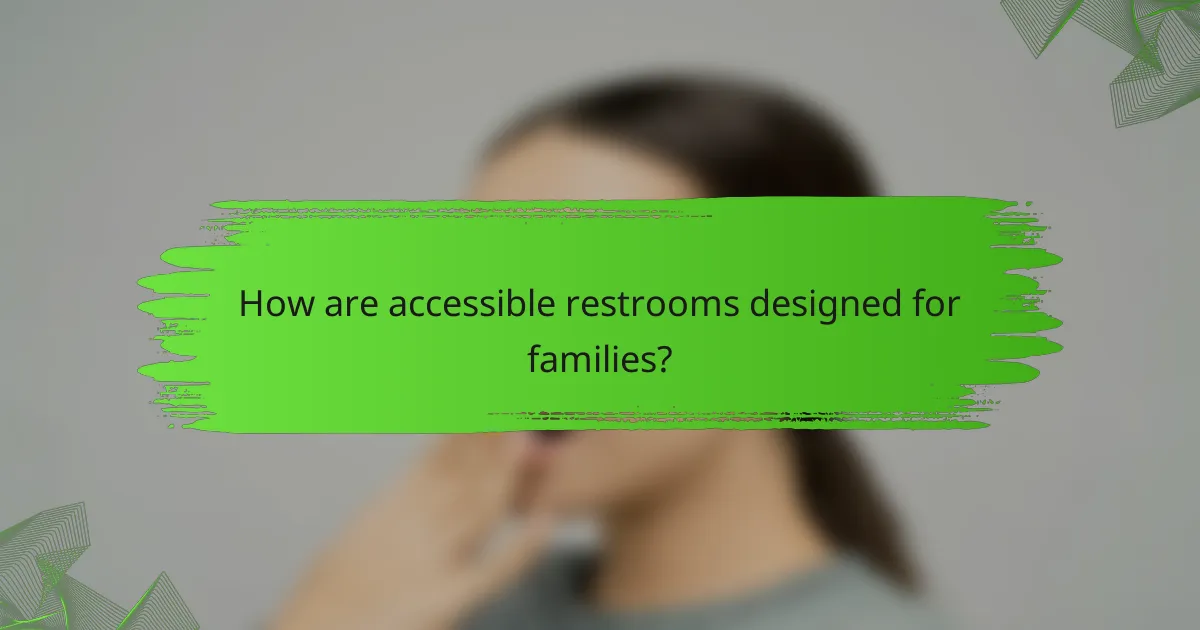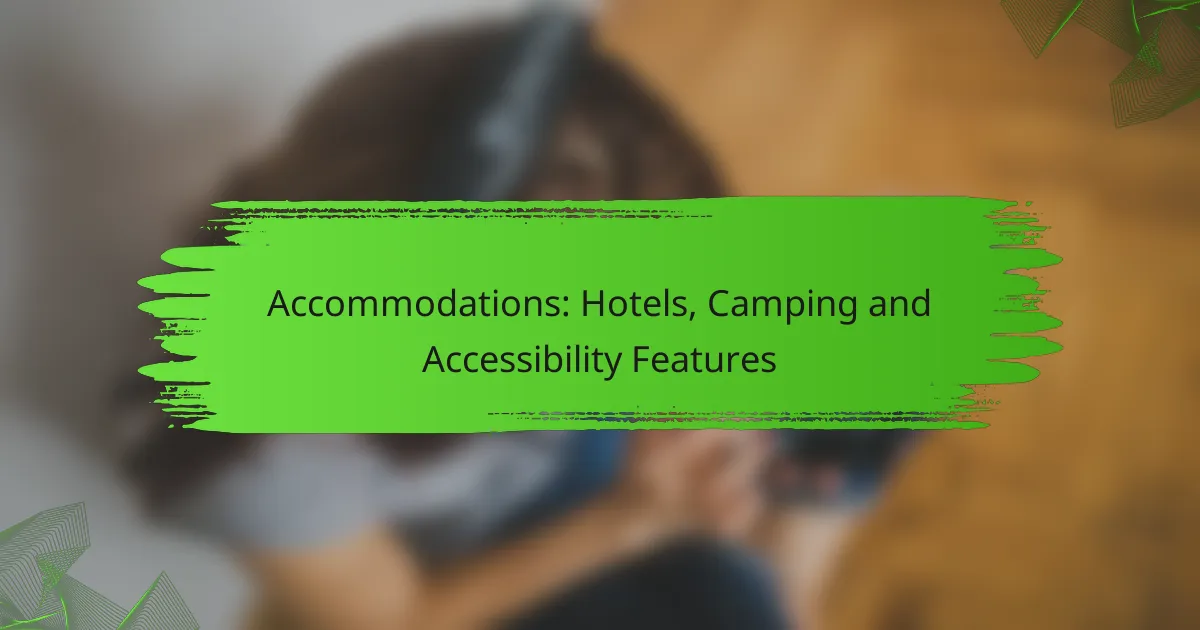Family-friendly facilities in public spaces are essential for accommodating the needs of families, especially those with young children. These areas typically feature kid zones for safe play, nursing areas for breastfeeding and bottle-feeding, and accessible restrooms, all designed to enhance comfort and convenience for parents and caregivers.

What are family-friendly facilities in public spaces?
Family-friendly facilities in public spaces are designated areas that cater to the needs of families, particularly those with young children. These facilities often include kid zones, nursing areas, and accessible restrooms, ensuring comfort and convenience for parents and caregivers.
Kid zones in parks
Kid zones in parks are specially designed play areas that provide a safe and engaging environment for children. These zones typically feature age-appropriate equipment such as swings, slides, and climbing structures, often enclosed to prevent wandering.
When visiting a park, look for signs indicating the presence of a kid zone and check for safety features like soft ground surfaces and regular maintenance. Many parks also offer shaded areas for parents to supervise their children comfortably.
Nursing areas in shopping malls
Nursing areas in shopping malls are private spaces equipped for breastfeeding and bottle-feeding. These areas often include comfortable seating, changing tables, and sometimes even amenities like sinks for cleaning up.
When shopping, locate nursing areas by checking mall directories or asking customer service. It’s advisable to visit during less busy hours for a more peaceful experience, and some malls may offer family restrooms that include nursing facilities as well.
Accessible restrooms in airports
Accessible restrooms in airports are designed to accommodate individuals with disabilities and families traveling with young children. These restrooms typically feature larger stalls, grab bars, and changing tables for infants.
Before your trip, familiarize yourself with the airport layout to locate accessible restrooms. Many airports provide clear signage, and it’s helpful to plan for potential wait times during busy travel periods. Always check if the facilities meet your needs, especially when traveling with a family.

How do kid zones enhance family experiences?
Kid zones significantly enhance family experiences by providing safe, engaging spaces for children to play while parents relax. These areas are designed to cater to the needs of families, ensuring that both children and adults can enjoy their time together in a comfortable environment.
Safe play areas
Safe play areas are crucial in kid zones, as they minimize the risk of injury while children explore and interact. These spaces typically feature soft flooring, padded equipment, and age-appropriate structures to ensure safety. Parents should look for areas that comply with local safety standards, such as those set by the Consumer Product Safety Commission (CPSC) in the U.S.
When choosing a venue with a kid zone, consider the layout and visibility of the play area. Parents should be able to easily supervise their children while they play, which enhances peace of mind. Facilities that offer enclosed spaces or clear sightlines can be particularly beneficial.
Interactive activities
Interactive activities in kid zones encourage children to engage with their surroundings and develop social skills. These can include climbing walls, art stations, or interactive games that promote teamwork and creativity. Look for venues that rotate activities regularly to keep the experience fresh and exciting for repeat visits.
Parents should also consider the age appropriateness of the activities offered. Facilities that provide a range of options for different age groups can accommodate siblings and friends, ensuring everyone has something to enjoy. Additionally, check if there are staff members available to facilitate activities, as this can enhance the overall experience for children.

What features should nursing areas include?
Nursing areas should provide a private, comfortable space for breastfeeding or bottle-feeding, ensuring both privacy and convenience for parents. Essential features include private nursing rooms, comfortable seating, and changing tables to accommodate the needs of families with young children.
Private nursing rooms
Private nursing rooms are crucial for mothers who wish to breastfeed or pump milk in a discreet environment. These rooms should be soundproofed to minimize distractions and provide a calming atmosphere. Ideally, they should be equipped with a lockable door for added privacy.
When designing these spaces, consider including amenities like a sink for easy clean-up, electrical outlets for breast pumps, and soft lighting to create a relaxing ambiance. Ensuring that these rooms are easily accessible throughout the facility will enhance their usability.
Comfortable seating
Comfortable seating is essential in nursing areas to support mothers during feeding sessions. Chairs should be ergonomically designed, providing adequate back support and armrests for ease of use. Options like recliners or cushioned armchairs can enhance comfort during longer feeding times.
Additionally, consider providing seating that accommodates both mothers and their partners or caregivers, allowing for family bonding during feeding. Ensuring that seating is spaced appropriately can also help maintain privacy while still being accessible.
Changing tables
Changing tables are a vital feature in nursing areas, providing a safe and hygienic space for diaper changes. These tables should be sturdy, with safety straps to secure the child during the process. Ideally, they should be located near the nursing area for convenience.
It’s beneficial to include a supply of disposable changing pads and wipes to enhance cleanliness. Regular maintenance and restocking of these supplies are essential to ensure a positive experience for families using the facility.

How are accessible restrooms designed for families?
Accessible restrooms for families are designed to accommodate the needs of parents and caregivers, ensuring comfort and convenience for both adults and children. These facilities typically feature spacious layouts, child-friendly fixtures, and accessible amenities that promote ease of use for everyone.
Spacious layouts
Spacious layouts in accessible restrooms allow for easy movement, especially for parents with strollers or children needing assistance. These restrooms often include wider doorways, turning spaces, and sufficient room for multiple users, which can be crucial during busy times.
Design standards generally recommend a minimum of 1.5 meters in width for turning areas, ensuring that caregivers can maneuver without difficulty. This extra space is essential for accommodating various needs, such as changing diapers or assisting children with personal hygiene.
Child-friendly fixtures
Child-friendly fixtures in accessible restrooms enhance usability for younger visitors. These may include lower sinks, toilets with child-sized seats, and grab bars that are positioned within reach of children. Such features help instill independence in kids while ensuring safety.
Additionally, hands-free options like foot pedals or sensor-activated faucets can be beneficial, reducing the need for physical contact and promoting hygiene. Caregivers should look for restrooms that incorporate these elements to create a welcoming environment for families.

What are the benefits of family-friendly facilities?
Family-friendly facilities provide essential support for parents and caregivers, enhancing the overall experience for families. These amenities, such as kid zones, nursing areas, and accessible restrooms, cater to the specific needs of families, making outings more enjoyable and stress-free.
Increased visitor satisfaction
Family-friendly facilities significantly boost visitor satisfaction by addressing the unique needs of families. When parents find amenities like clean nursing areas and safe play zones, they feel more comfortable and are likely to return. This satisfaction can lead to positive word-of-mouth, further attracting families to the location.
For example, venues that offer dedicated spaces for children to play or relax can create a more enjoyable atmosphere for everyone. Parents can focus on their activities while knowing their children are entertained and safe, leading to a more pleasant experience overall.
Encouragement of longer stays
Having family-friendly facilities encourages families to extend their visits. When amenities are available, families are more inclined to spend additional time at a location, exploring all it has to offer. This can result in increased spending on food, merchandise, and activities.
For instance, a family-friendly park with a designated play area and nursing stations may entice families to stay for several hours rather than just a quick visit. This not only benefits the families but also enhances revenue opportunities for the venue.

What criteria should be considered when selecting family-friendly facilities?
When selecting family-friendly facilities, consider accessibility, safety, and the availability of amenities tailored for children and caregivers. Prioritizing these factors ensures a comfortable and enjoyable experience for families.
Location accessibility
Location accessibility is crucial for family-friendly facilities, as it determines how easily families can reach them. Facilities should be situated near public transportation, parking areas, and pedestrian-friendly pathways to accommodate parents with strollers or children who may need assistance.
Evaluate the surrounding environment for potential barriers, such as busy roads or lack of sidewalks. Facilities located in urban areas often have better access to amenities, while those in rural settings may require more planning to reach.
Additionally, check for wheelchair access and appropriate signage to guide families. Accessible entrances and restrooms are vital for ensuring that all family members can enjoy the facility without hindrance.



